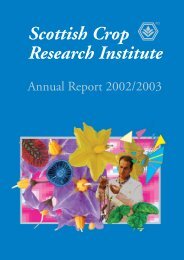SCRI Annual Report 2003/2004 - Scottish Crop Research Institute
SCRI Annual Report 2003/2004 - Scottish Crop Research Institute
SCRI Annual Report 2003/2004 - Scottish Crop Research Institute
You also want an ePaper? Increase the reach of your titles
YUMPU automatically turns print PDFs into web optimized ePapers that Google loves.
Director’s <strong>Report</strong><br />
aim was to provide more accountable government in<br />
Scotland and Wales within the framework of the UK.<br />
The <strong>Scottish</strong> Parliament and Executive will be responsible<br />
for health; education and training; local government,<br />
social work and housing; economic<br />
development and transport; the law and home affairs;<br />
the environment; sports and the arts; research and<br />
statistics, and agriculture, fisheries and forestry.<br />
Reserved to the UK Parliament will be the constitution;<br />
UK foreign policy; UK defence and national<br />
security; the UK’s fiscal macroeconomic and monetary<br />
system; common markets for UK goods and services;<br />
employment legislation; social security; and most<br />
aspects of transport safety and regulation. Relations<br />
with the EU will remain the ultimate responsibility of<br />
the UK Government but the <strong>Scottish</strong> Executive will be<br />
involved in decision-making on Europe. <strong>SCRI</strong> was<br />
one of the <strong>Scottish</strong> Public Bodies listed in Annex A of<br />
the July 1997 White Paper Scotland’s Parliament (Cm<br />
3658). These are deemed to have a remit which is<br />
concerned with matters to be devolved. Other such<br />
bodies include the other four <strong>Scottish</strong> Agricultural and<br />
Biological <strong>Research</strong> <strong>Institute</strong>s, the Royal Botanic<br />
Garden, Edinburgh, the <strong>Scottish</strong> Higher Education<br />
Funding Council, water authorities, health bodies, and<br />
advisory bodies. The SABRI remits clearly extend<br />
beyond the UK, but have a special relationship with<br />
Scotland. Any changes to the Annex A bodies will<br />
depend on ministerial decisions. The <strong>Scottish</strong><br />
Executive will be able to alter the structure or wind-up<br />
existing bodies, and create new ones. It will also be able<br />
to alter budgets to suit its own priorities. 1997-1998.<br />
Devolution in the UK Devolution developed during<br />
the course of 2000. The Westminster-based UK<br />
Parliament remained the supreme law-making authority,<br />
legislating for the UK as a whole, or for any parts of<br />
it. Sovereignty resides with the Queen in Parliament.<br />
The main functions of Parliament are to pass laws, to<br />
provide the means of carrying on the work of government<br />
by imposing taxes, and to scrutinise government<br />
policy and administration. All international treaties<br />
and agreements are presented to Parliament before ratification.<br />
Contrasting with most countries, the UK<br />
constitution is not contained in a single document but<br />
has slowly evolved, and been shaped by statute, common<br />
law, and by convention. Membership of the<br />
European Union poses constraints and overrides, however.<br />
Following its election on 6 May 1999, the<br />
<strong>Scottish</strong> Parliament exerted legislative power over all<br />
devolved powers, i.e. matters not reserved to<br />
Westminster; primary legislation can be introduced,<br />
and the <strong>Scottish</strong> Parliament has the power to raise or<br />
lower the basic rate of income tax by three pence in the<br />
pound. The areas of responsibility cover agriculture<br />
(including agricultural R&D), economic development,<br />
education, environment, financial assistance to industry,<br />
fire services, food standards, forestry, heritage and<br />
the arts, health, housing, law, planning, police, and<br />
some aspects of transport. A busy year was experienced<br />
by the <strong>Scottish</strong> Parliament (see <strong>Scottish</strong><br />
Parliament <strong>Annual</strong> <strong>Report</strong> 2000 to 2001). Thirteen<br />
bills were passed, 14 bills received Royal Assent, 71<br />
members’ business debates were held, large numbers of<br />
questions were lodged, and answered either in<br />
Chamber or in writing. The Committees of the<br />
<strong>Scottish</strong> Parliament gained a higher profile. Of relevance<br />
to this report was the work of the Rural<br />
Development (formerly Rural Affairs) Committee<br />
which devoted considerable time to the controversial<br />
Protection of Wild Mammals (Scotland) Bill, but<br />
became increasingly involved in the alarming outbreak<br />
of foot and mouth disease. Other topics covered by<br />
this committee included an inquiry into the effect of<br />
changing employment patterns in rural areas.<br />
Following a petition, GM crops were considered in a<br />
report by the Transport and the Environment<br />
Committee; this Committee also considered a petition<br />
on the environmental effects of an oilseed-crushing<br />
plant in Arbroath. Petitions from the public were firstly<br />
reviewed by the innovative Public Petitions<br />
Committee, a noteworthy democratic initiative.<br />
Cross-party groups were also active. The National<br />
Assembly for Wales was also elected in 1999 and has<br />
the power to make secondary legislation in the areas<br />
where it has been granted executive functions. The<br />
New Northern Ireland Assembly elected in 1998 was<br />
due to be formally established by legislation in 1999.<br />
It was suspended in February 2000 and resumed sitting<br />
in June 2000, and had legislative authority in the<br />
fields administered by the Northern Ireland departments.<br />
2000-2001.<br />
The Dome In the UK, the Millennium Dome was<br />
built to celebrate the year 2000. Standing on the<br />
prime meridian on a reclaimed site in Greenwich, near<br />
to the Thames Barrage, the Dome was noted for its<br />
roof of tensioned fibreglass membrane covering 8<br />
hectares and suspended from 12 masts. Such is the<br />
standing of science that early hopes that the building<br />
would house British scientific, engineering and technological<br />
achievements, and exciting new R&D projects,<br />
did not materialise, despite an expenditure on the<br />
building of over £600m derived for the most part from<br />
National Lottery funds. 1999-2000.<br />
18
















